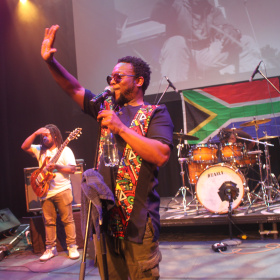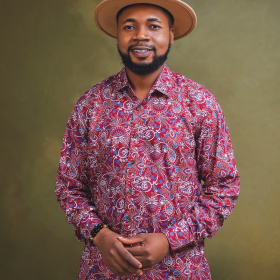Burkinabe women in music
By Hervé David Honla
Burkinabe music is part of the national cultural heritage and women have always played a leading role in this field. This text gives an overview of the role of women in music in this West African country.
 Awa Sissao.
Awa Sissao.
Introduction
Music is a fundamental component in the history of Burkina Faso as much as it is in the rest of Africa. One cannot speak of music in Burkina Faso without referring to women. From the former French colony of Upper Volta to Burkina Faso after its independence, female singers played a key role, not only in the building of the new Burkina Faso nation but also in the valorisation of local rhythms. In particular, the women of the Moaga chiefdom have always been at the heart of all customary celebrations of the kingdom. Generally speaking, all the cultural aspects in the chiefdom are devoted to the larlé naaba (traditional chief) and women have always held major roles because they not only entertained the royal court but also greatly contributed to the creation of the Moaga musical identity.
Legends
When talking about the history of Burkinabe music, one woman’s name is recurrent throughout – Ado Gorgo Léontine, who is 86 years old* with a 67-year music career. She is the real queen of Burkinabe music. Propelled onto the national stage by Larlé Naaba Anbga, this singer from Kando in the province of Kouritenga was discovered by the public of Upper Volta through broadcasts of her storytelling as well as singing of tales and legends on national radio. Léontine later became the leader of an all-women group called La Troupe de Larlé, whose stories and songs were broadcasted in the entire Upper Volta. The other members of the group were Mariam Dermé, Abibo, Antine and Mariam. Léontine has travelled all over France (Marseille, Paris, Bordeaux and Lille) with her music and storytelling, and her troupe has maintained massive popularity since its formation in the 1940s. Well known songs by La Troupe de Larlé include ‘Yilgikom’, ‘Saow Yidma’, ‘Koukin Daaga’. The group was invited numerous times to perform in Ghana and Ivory Coast. Today, this troupe from the golden age of Burkinabe music is regarded as a national treasure and many modern musicians do not hesitate to return to it for inspiration.
After the death of Larlé Naaba Anbga, Léontine formed a new troupe called Namendé, which brought together many great traditional musicians, among them the late Amidou Zongo. Unfortunately the new group did not enjoy the same success as La Troupe de Larlé but had a major influence nonetheless. During the second conflict between Mali and Burkina Faso in 1985 when the countries’ leaders called for a patriotic movement on national radio, Léontine and her troupe composed songs matching the surge of this patriotic mood.
Inequality
Léontine’s traditional music inspired many young women to embrace a musical career, among them Marie Gayerie, Dori Foudingnabou and Nana Bibata. From thereon modern Burkinabe music was developed and more women, such as Amety Méria to Awa Nadia, emerged on the music scene. As of 2017 there are about 2 500 women affiliated to the Burkinabe Copyright Office (BBDA), who are present in all genres (traditional, hip hop, coupé-décalé, urban, reggae, madingue, zouk and gospel music, among others). The challenges, however, lie in the level of their professionalisation, recognition and absence at live events (there is less demand for women musicians in Burkina Faso than there is for men). For instance, in 17 editions of the Kundé Awards, which is the Burkinabe music industry’s biggest awards ceremony, only Amety Méria received the top honour, the Kundé d'Or, in 2004.
Furthermore, female musicians in Burkina Faso have no real platform to showcase their talent. Although they are invited to most regular national events, they are not treated like their male counterparts. This is the reason female musicians have created ABFAM (the Burkina Faso Association of Female Artists), whose objective is to promote their work and defend their rights. Chaired by Méria, ABFAM advocates for better treatment of female artists including competitive performances fees and equal representation at major events. The association also organises workshops and training, and advises its members.
Scams and sexual harassment, particularly with newcomers, are two well-known issues that female musicians in Burkina Faso are often afraid to talk about. “I suffered a lot of physical abuse because I was naïve” a famous artist, who wished to remain anonymous, said. Many women have persevered despite these problems while others have thrown in the towel to take up safer career options. More women are forced to abandon their dreams and put their music careers on hold, choosing to focus on family life or other more lucrative professions. Such artists include Sami Rama, Sonia Carré d'As, Mariam Rovane, Lobo Dicko and Toussy.
A popular genre
Gospel music is gaining more and more popularity, with many female artists entering the genre. Gospel concerts are becoming increasingly popular and drawing a large number of fans. The most famous female gospel artist is sister Palingwendé Anne-Marie Kaboré who in 2014 won a Kundé Award for best gospel artist.
Conclusion
A new generation of female artists is emerging on the Burkinabe music scene thanks to the new styles and genres that are entering the larger African music scene. L’ambiance facile (easy entertainment) is much appreciated by female artists such as Malika La Slameuse, Michuana, Woni, Mariah Bissongo, Tiness, Pamika, Nurat, Natou, Ashley, Besko, Daisy Franck, Wendy, Awa Sissao, Kandy Guira, Sali Sanou, Nabalüm and especially Sali Diabaté, one of the few women who plays traditional instruments, which are almost always exclusively reserved for men.
*in 2017
























Comments
Log in or register to post comments